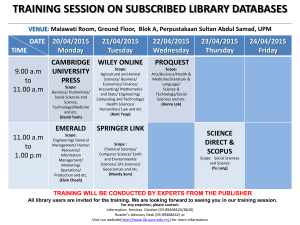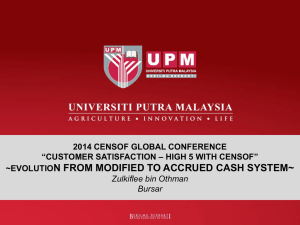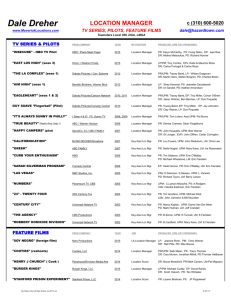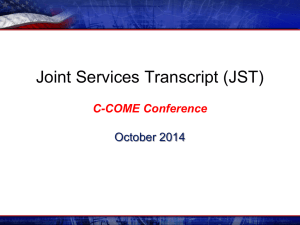Pertanika Journal - Universiti Putra Malaysia
advertisement
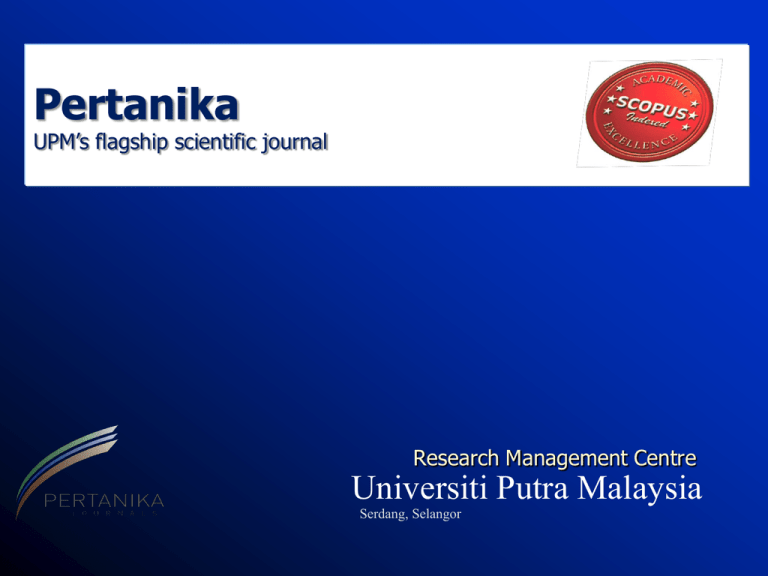
Pertanika UPM’s flagship scientific journal Research Management Centre Universiti Putra Malaysia Serdang, Selangor Pertanika’s Vision & Objectives Our goal is to bring high quality research to the widest possible audience. Pertanika aims for excellence, sustained by a responsible and professional approach to journal publishing. We value and support our authors in the research community. Visit journal's profile at http://www.pertanika2.upm.edu.my/jpertanika/index.htm 4/13/2015 4 Organisation Chart University Publications Committee Jawatankuasa Kerja Penerbitan Universiti (JKPU) Chairman Mohd Saleh Jaafar (Professor Dr.) Deputy Vice Chancellor (R&I) Pertanika Journal Publication Working Committee Chairman: Nayan Deep S. KANWAL (Dr.) Deputy Director, Journal Division, UPM Press Secretary: Erica Kwan Lee Yin (Ms.) 3 Chief Editors (JTAS, JST & JSSH) UPM Press representative Pertanika Journal Editorial Board Committees (Pertanika JTAS) (Pertanika JST) (Pertanika JSSH) Editorial Board JTAS Editorial Board JST Editor-in-Chief Editor-in-Chief Editor-in-Chief Tan Soon Guan (Professor Dr.) Faculty of Biotechnology & Biomolecular Sciences Mohd. Ali Hassan (Professor Dr.) Faculty of Biotechnology & Biomolecular Sciences Mohd Shahwahid Othman (Professor Dr.) Faculty of Economics & Management Editorial Board JSSH Executive Editor Executive Editor Executive Editor Dr. Nayan Deep S. Kanwal Research Management Centre (23 Members) Dr. Nayan Deep S. Kanwal Research Management Centre (29 Members) Dr. Nayan Deep S. Kanwal Research Management Centre (27 Members) JTAS Editorial Advisory Board JST Editorial Advisory Board (10 Members) 4/13/2015 (11 Members) JSSH Editorial Advisory Board (15 Members) 6 Pertanika’s Origin The word Pertanika was derived from Pertanian. UPM started as an Agriculture based institution, in line with this, the first journal to reflect ‘Pertanian’ was started off under the dynamic leadership of the 1st Vice Chancellor, Prof. Emeritus Tan Sri Dato’ Dr. Mohd. Rashdan Baba. – Dr. J.J. Augustine (founder Editor-in-Chief (1978-1982) – Prof. Chin Hoong Fong (1983-1996). – Prof. Tan Soon Guan (1997-current). 4/13/2015 7 Pertanika’s Background Pertanika is the only official journal of Universiti Putra Malaysia. It is an international peer-reviewed leading journal in Malaysia devoted to the publication of original research. Pertanika Journal of Tropical Agricultural Science (JTAS) began publication in 1978. In 1992, a decision was made to streamline Pertanika into 3 journals— other 2 being; Journal of Science & Technology (JST) and Journal of Social Sciences & Humanities (JSSH). 4/13/2015 8 Pertanika’s Publication Policy In its continuous efforts to make Pertanika a highly regarded academic journal, a Code of Ethics was recently developed. This is primarily intended to specifically address issues pertaining to publication ethics and conducts such as plagiarism, authorship and copyright, as well as other relevant matters which are apparently becoming visible. Pertanika takes plagiarism seriously. Manuscripts received undergo an ‘Originality check’ using T u r n I t I n software. Want to know more? Ask the Executive Editor for Pertanika’s Code of Ethics 4/13/2015 10 Pertanika’s Market Potential Pertanika is an academic Malaysian-international journal catering to researchers, authors, postgraduate students and scholars from all over the world. To reach out to the widest possible research community. To achieve the citation-index and impact factor for Pertanika Journals by 2013! (Thomson ISI) 4/13/2015 Pertanika is the recipient of the Majlis Penerbitan Ilmiah Malaysia (MAPIM) Special Award 11 About the Journal JTAS JTAS or Pertanika J. Trop. Agric. Sci. accepts and publishes articles in English. It is open to authors around the world regardless of their nationality. Currently, JTAS is published four times a year, i.e. in February, May, August and November 4/13/2015 12 About the Journal JST JST or Pertanika J. Sci. Technol. accepts and publishes articles in English. It is open to authors around the world regardless of their nationality. Currently, JST is published two times a year, i.e. in January and July. 4/13/2015 13 About the Journal JSSH JSSH or Pertanika J. Soc. Sci. Hum. is open to authors around the world regardless of their nationality. It accepts and publishes papers in English. Currently, JSSH is published four times a year, i.e. in March, June, September and December. 4/13/2015 14 Scope JTAS Pertanika Journal of Tropical Agricultural Science (JTAS) Tropical Agricultural Research Agricultural Biotechnology Biochemistry Biology Ecology Entomology Fisheries Food sciences Forestry Genetics Microbiology Pathology and management Physiology Plant and Animal Sciences Production of Plants & Animals of Economic Importance Veterinary Medicine Full list available at: www.pertanika.upm.edu.my/ 4/13/2015 15 Scope JST Pertanika Journal of Science and Technology (JST) Bioinformatics Bioscience Biotechnology and Biomolecular Sciences Environmental Control and Management Mathematics and Statistics Medicine and Health Sciences Chemistry Computer Science Nanotechnology Ecology Physics Engineering Engineering Design Safety and Emergency Management Full list available at: www.pertanika.upm.edu.my/ 4/13/2015 16 Scope JSSH Pertanika Journal of Social Sciences and Humanities (JSSH) Accounting Agricultural & Resource Economics Anthropology Communications Community and Peace Studies Consumer Studies Design and Architecture Economics Education Extension Education Finance Gerontology Hospitality and Tourism Human Ecology Human Resource Development Language Studies Language Literature Legal Studies Management Marketing Psychology Safety and Environment Social and Behavioral Sciences Sociology Full list available at: www.pertanika.upm.edu.my/ 4/13/2015 17 Why should you Publish in Pertanika? Rapid publication of research findings. A decision of acceptance of a manuscript is reached with in 2 to 3 months (average 12 weeks). The elapsed time from submission to publication for an article averages 5-6 months. 4/13/2015 Pertanika’s acceptance rate averaged to about 60% in the last 6 months. This also means that the Journal’s rejection rate is about 40%. 18 Submission Guidelines 1/4 Manuscript preparation Pertanika Journals accept submission of mainly four types of manuscripts: – Regular or Original articles Full-length original empirical investigations, consisting of introduction, materials and methods, results and discussions. – Short communications Significant new information to readers of the Journal in a short but complete form. – Review article Critical evaluation of materials about current research that had already been published by organizing, integrating, and evaluating previously published materials. – Special issues Usually papers from research presented at conferences, seminars, congress or a symposium. 4/13/2015 19 Submission Guidelines 2/4 Format Should be type-written on one side of A4 paper. One column format with the figures at the end. Maximum of eight keywords in alphabetical order. 4/13/2015 At least 4cm margins on all sides & double-line spacing. Times New Roman, 12-point font size. 20 Submission Guidelines 3/4 Format (contd.) 4/13/2015 Running Title: Not exceeding 50 characters, including letters and spaces. Corresponding Author: Provide full address. Abstract: About 250 words for regular paper, and up to 100 words for short communications. Text: Regular papers should comprise of Introduction, Materials and Methods, Results and Discussions, and Conclusions. References: Use the latest version of the Publication Manual of the American Psychological Association (APA) style. 21 Submission Guidelines 4/4 The format for the 1st four pages is as below: 1st page: Title of the paper only. 2nd Page: Title of the paper + Authors’ names + Corresponding author’s name and full address, together with email and telephone number. 3rd Page: Title of the paper + Abstract + Keywords only. 4th Page: Introduction, etc. Style of the manuscript American Psychological Association (APA). American or British spelling. http://www.pertanika.upm.edu.my/ 4/13/2015 22 Submitting your Manuscript E-mail Submissions As of now, you could submit your articles via email to the Executive Editor to be properly acknowledged and rapidly processed. Manuscript must be in Pertanika style, (MS WORD file format). Include the following submission form and a Cover letter from the Corresponding Author: 4/13/2015 Manuscript Submission KIT comprising of : Declaration Form and Referral Form. 24 Call for Papers Pertanika invites you to explore frontiers from all fields of Agriculture, Science and Technology to Social Sciences and Humanities. Pertanika welcomes both quantitative and qualitative research. You may contribute your scientific work for publications in UPM's hallmark journals, either as a regular article, short communication, or review article. 4/13/2015 25 Call for Papers Further details can be obtained from the Executive Editor’s office@TNCPI. 4/13/2015 26 Pertanika is the resource that supports you in strengthening research and research management capacity. Visit the Journal’s Profile at http://www.pertanika.upm.edu.my/ 4/13/2015 27 Mail Submissions or Get More Information The Executive Editor (Pertanika Journals) Journal Division, UPM Press Office of the Deputy Vice Chancellor (R&I) 1st Floor, IDEA Tower II, UPM-MTDC, Technology Centre, 43400 UPM, Serdang Selangor Darul Ehsan Tel: +603 8947 1622 E-mail: ndeeps@admin.upm.edu.my WebSite: http://www.pertanika.upm.edu.my/ 4/13/2015 28 4/13/2015 29
